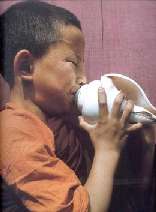 This webpage will explore the relationship between symbols in Tibetan Buddhism and how these cultural expressions give insight into the cultural and religious identity of Tibet. These Tibetan symbols are unique, colorful, expressive and have a long history with the people of this region, offering a great insight into the world of Tibetan Buddhism.
This webpage will explore the relationship between symbols in Tibetan Buddhism and how these cultural expressions give insight into the cultural and religious identity of Tibet. These Tibetan symbols are unique, colorful, expressive and have a long history with the people of this region, offering a great insight into the world of Tibetan Buddhism.
Symbols are a great way to teach about a concept, offering insights into ideas, concepts, beliefs, doctrines and feelings.
Symbols can often have powerful meaning, evoking strong emotions, with a long history.
For a symbol to have significance though, its meaning must be known to the viewer.
Symbolism is the oldest form of visual communication.
BRIEF HISTORY OF SYMBOLISM IN BUDDHISM
Buddhist symbols need to be considered within the culture of the people who follow it. Therefore, many of the early symbols relate to ancient India and can be found in Hinduism as well, although possibly with a somewhat different meaning.
The historical Buddha lived around the sixth century BCE, but no Buddhist artifacts are known from before the third century BCE. In the scriptures, it is mentioned that the Buddha did occasionally use images like the ‘Wheel of Life’ to illustrate the teachings. The first archaeological evidence, mainly of ornamental stone carvings, comes from the time of the Emperor Asoka (273 – 232 BCE), who converted to Buddhism and made it a popular religion in India and beyond .
In the second century BCE, people started to excavate Buddhist monasteries in rock, creating a large amount of artwork to withstand the ages. Probably the earliest typical Buddhist monument is the stupa, which was often specially decorated. The first actual Buddha images appeared around the first century BCE, so until then the artwork was largely symbolic in nature.
With the appearance of Buddhist Tantra around the 6th century, a wealth of new artwork and symbolism appeared, as imagination and visualization form a major technique in meditation practices. From this moment on, a pantheon of deities and protectors appeared, together with a vast collection of symbolic items, such as the vajra and bell and mandalas. This tradition was mainly preserved in so-called ‘Tibetan Buddhism’, and partially in the Japanese Shingon tradition.
Tibet is a vast country, spread out between India and the Himalayas in the South, and China in the east. The traditional nomadic culture was greatly influenced by the introduction of Buddhism from India, to an extent that nearly all the cultural achievements of Tibet are related to the Buddhist religion. Because of the predominance of tantra with its rich tradition of symbolism, it is no surprise that symbols and symbolic artifacts of all sorts are found in Tibet. Some of the symbols however originated in Tibet, or were given a specific meaning within the local culture.
